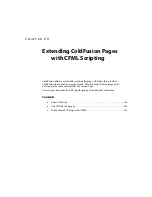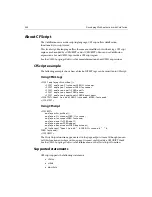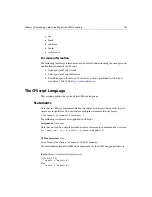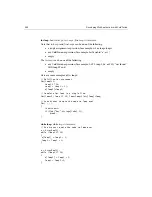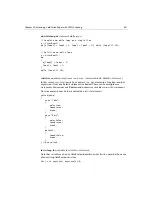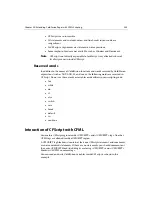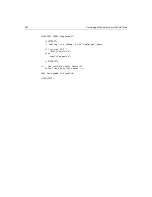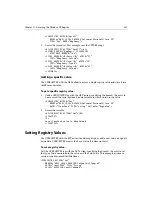
Chapter 19: Using CFOBJECT to Invoke Component Objects
333
•
If VisiBroker is already installed on the server, the log directory is the directory
pointed to by the
VBROKER_ADM
environment variable.
•
If this is a new VisiBroker installation, the log directory is created on the root of
the drive from which ColdFusion Server is started. For example, if ColdFusion is
installed in
c:\cfusion
or
opt/coldfusion
(UNIX), then the log directory will
be
c:\vbroker\log
or
/vbroker
(UNIX).
•
If the creation of the log directory on the root fails, then the directory is created
in the ColdFusion installation directory.
Calling a CORBA Object
In the CFOBJECT tag, several key attributes are required for calling CORBA objects:
•
Set the TYPE attribute to CORBA. If no TYPE is specified, COM is assumed.
•
The CONTEXT attribute shows how the object reference is obtained. Set the
CONTEXT either to "IOR" for a file containing the object’s unique
Interoperable Object Reference or to "NameService".
•
If the CONTEXT attribute is set to IOR, set the CLASS attribute to the file
containing the stringified version of the IOR. ColdFusion must be able to read
this IOR file at all times, so it should be local to the server or on the network in
an accessible location.
•
If the CONTEXT attribute is set to a NameService, the CLASS attribute must
include a period-delimited name such as Allaire.Department.Dev. Currently
ColdFusion can only resolve objects registered in VisiBrokers’s Naming Service.
This will change when ORB vendors implement the CORBA 3.0 specification.
Make sure that the NamingService (NS) is brought-up with a default
NamingContext. The server implementing the object should bind to the default
context, and register the appropriate name. ColdFusion also binds to the
default context to resolve the name.
•
Set the NAME attribute to the name your application uses to call the object’s
operations and attributes.
See the CFML Language Reference for the complete CFOBJECT syntax.
Declaring structures and sequences
Once the object is created, attributes and operations on the object can be invoked
using the syntax outlined in the above sections. In addition, ColdFusion also supports
the use of complex types such as structures and sequences. For structures, use
ColdFusion structures. For sequences, use ColdFusion arrays.
Example
The IDL for an object
struct SimpleStruct
Содержание COLDFUSION 4.5-DEVELOPING WEB
Страница 1: ...Allaire Corporation Developing Web Applications with ColdFusion ColdFusion 4 5...
Страница 14: ...xiv Developing Web Applications with ColdFusion...
Страница 26: ...xxvi Developing Web Applications with ColdFusion...
Страница 34: ...8 Developing Web Applications with ColdFusion...
Страница 70: ...44 Developing Web Applications with ColdFusion...
Страница 84: ...58 Developing Web Applications with ColdFusion...
Страница 114: ...88 Developing Web Applications with ColdFusion...
Страница 148: ...122 Developing Web Applications with ColdFusion...
Страница 174: ...148 Developing Web Applications with ColdFusion...
Страница 208: ...182 Developing Web Applications with ColdFusion...
Страница 244: ...218 Developing Web Applications with ColdFusion...
Страница 274: ...248 Developing Web Applications with ColdFusion...
Страница 288: ...262 Developing Web Applications with ColdFusion...
Страница 300: ...274 Developing Web Applications with ColdFusion...
Страница 350: ...324 Developing Web Applications with ColdFusion...
Страница 362: ...336 Developing Web Applications with ColdFusion...



















